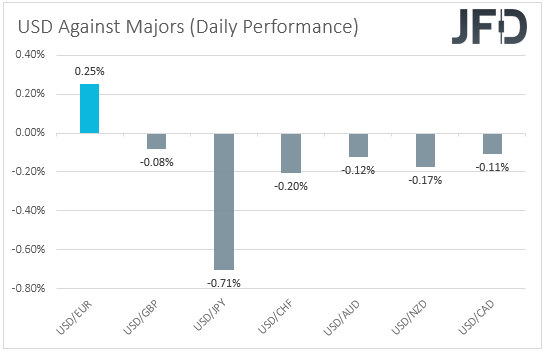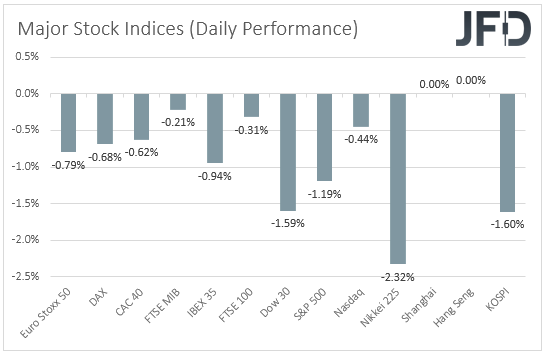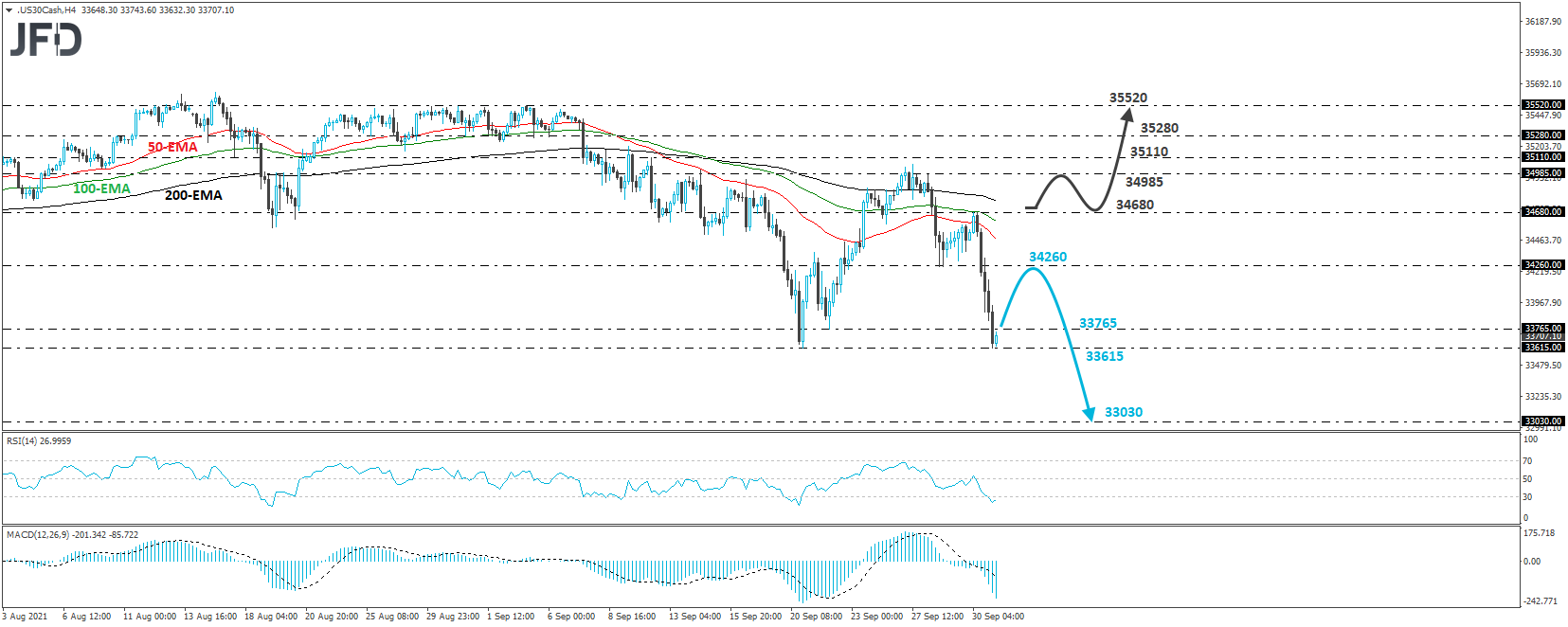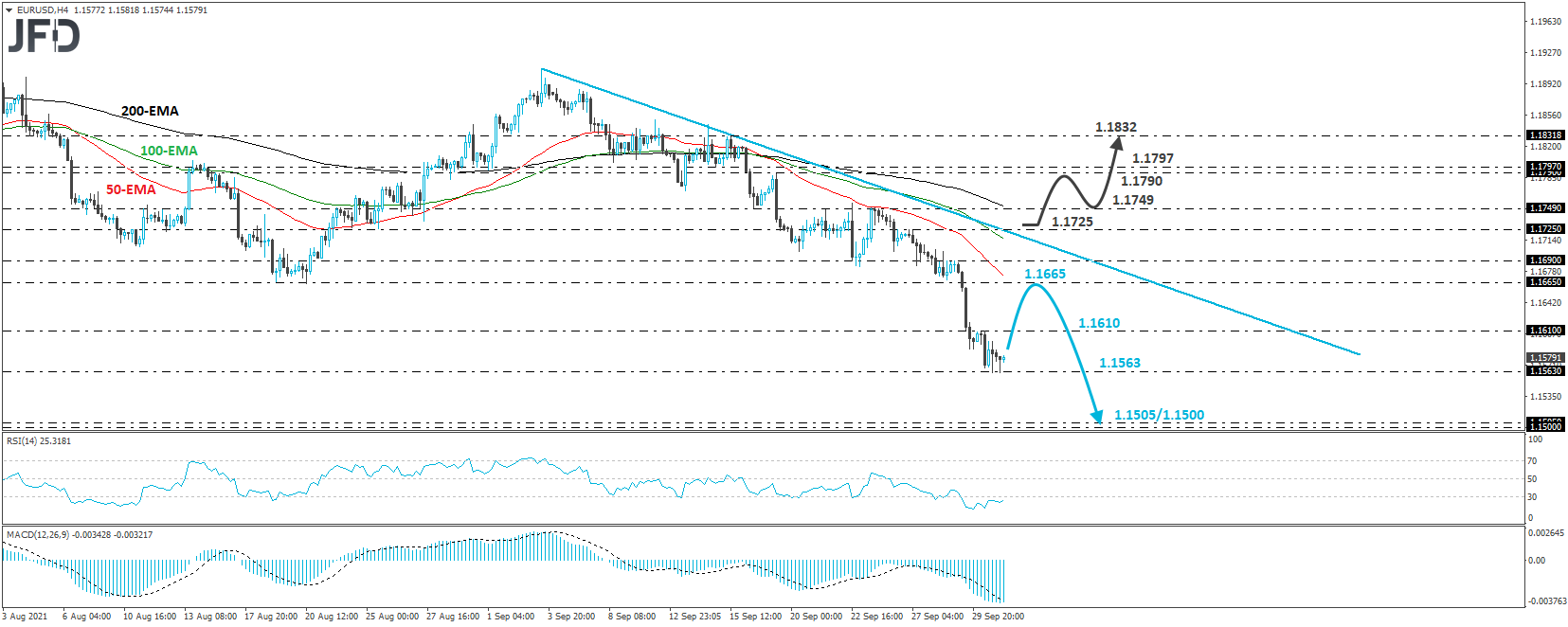The US dollar pulled back yesterday, and equities traded lower, suggesting that market participants remained wary. Persistently high inflation, the deadlock in US Congress over the debt ceiling, and fears of Evergrande (OTC:EGRNY) defaulting after it missed a second offshore bond payment are among the factors causing uncertainty.
US Dollar Retreats But Equities Slide
The US dollar pulled back against all major currencies except the euro on Thursday and during the Asian session Friday. Meanwhile, it slid the most against the yen.

The performance in the FX world does not paint a clear picture with regards to the broader market sentiment this time around. The yen's strengthening suggests a risk-off environment, but the retreat of the US dollar points otherwise.
Thus, we prefer to turn our gaze to the equity world. We see that major EU and US indices closed in negative territory, with risk aversion rolling into the Asian session today. Japan’s Nikkei 225 and South Korea’s KOSPI fell 2.32% and 1.60% respectively. China’s Shanghai Composite and Hong Kong’s Hang Seng remained closed.

So, why did the dollar retreat? Market chatter suggests that this may have been due to initial jobless claims rising by more than anticipated last week. But this would have proved positive for equities, at least the US ones, as it could mean that the labor market is not at the desired state, which may be a reason for delaying the beginning of Quantitative Easing (QE) tapering.
In our view, the dollar may have pulled back due to some profit-taking after its latest steep rally. Participants booked profits at the end of the month and might jump back into the action at a later stage. We believe that, even if the retreat continues for a while more, the fundamental background remains the same, and thus, we would expect the greenback to rebound and continue heading north for now.
As for today, the most critical piece of data on the agenda is Eurozone's preliminary CPIs for September. The headline CPI rate is expected to rise +3.3% YoY from +3.0%, while the HICP excluding energy and food could increase to +1.9% YoY from +1.6%.
Despite the headline rate moving further above the European Central Bank's (ECB) objective of 2%, underlying inflation is expected to stay below that target, something that may allow the ECB to remain accommodative for longer than other central banks.
During their latest meeting, officials of this Bank announced a "moderately lower pace" in its Pandemic Emergency Purchase Program (PEPP). Still, they clarified that this is not a tapering move, and when PEPP is over, they have all the other tools available.
So, we expect the euro to stay under selling pressure, especially against the dollar, given that the Fed could start scaling back QE in November and perhaps start raising interest rates next year.
DJIA – Technical Outlook
The Dow Jones Industrial Average cash index tumbled again yesterday, and today, during the Asian session, it hit the 33615 support, marked by the low of Sept. 20. Even if we see another round of buying, the price structure has been of lower highs and lower lows recently, which paints a negative short-term picture.
A potential recovery may extend towards the 34260 zone, marked by the inside swing low of Sept. 28, but we see decent chances for the bears to jump back into the action from near that zone. Another slide could result in another test at 33615, the break of which will confirm a forthcoming lower low and perhaps see scope for extensions towards the 33030 territories, defined as a support by the low of Jun. 21.
On the upside, we will only abandon the short-term bearish case if we see a break above yesterday's high of 34680. This will confirm a forthcoming higher high on the 4-hour chart and aim for Tuesday's peak, at 34985, or the high of Sept. 10, at 35110. Another break higher could extend the advance towards the 35280 zone, which provided strong support between Aug. 31 and Sept. 6.
EUR/USD – Technical Outlook
EUR/USD fell sharply on Wednesday, breaking below the 1.1665 barrier, which provided support on Aug. 19 and 20. Yesterday, the pair hit support at around 1.1563 before consolidating. Overall, the rate continues to trade well below the downside resistance line drawn from the high of Sept. 3. We consider the short-term view negative.
The current consolidation suggests we may see a corrective bounce soon, perhaps even above 1.1610, which is yesterday's high. However, the rate would still be below the downside line, and the bears may retake charge from below the 1.1665 barrier.
This may result in another slide to the 1.1563 level, the break of which could pave the way towards the 1.1505 level, marked by the low of Jul. 22, or the psychological figure of 1.1500.
On the upside, we would like to see a recovery above the 1.1725 zone to start examining whether the outlook has turned bullish. This could confirm the break above the pre-mentioned downtrend line and could initially target the 1.1749 zone, marked by the high of Sept. 23.
A break above that zone could trigger extensions towards the 1.1790/1.1797 zone, the break of which could encourage more advances, perhaps towards the peak of Sept. 15, at 1.1832.
As For The Rest of Today's Events
Besides the Eurozone CPIs, US personal income and spending numbers for August and the core PCE index for the month are out. The ISM manufacturing index for September is also on the agenda, and the forecast points to a small decline, to 59.5 from 59.9. From Canada, we get the monthly GDP for July.
